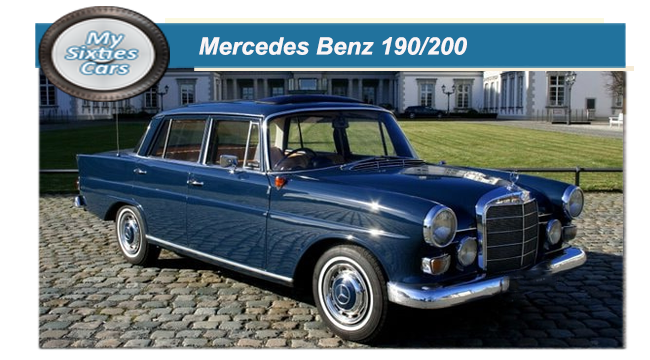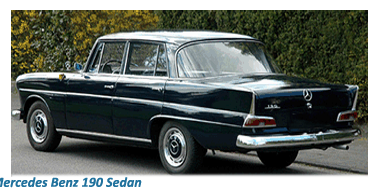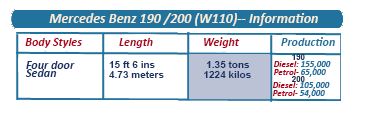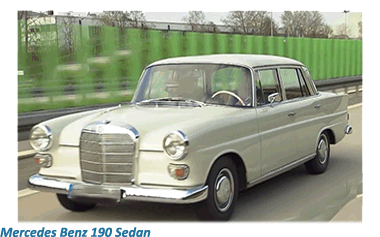
The release of the Mercedes-Benz 190 W110 series in 1962, marked the beginning of a period of transition from the almost dour stability of West Germany in the Fifties as the country strived to restore their credibility on the World automotive stage.
Still bearing a strong resemblance to its predecessor the 180, although with its longer bonnet giving the car a more angular appearance,the 190 sedan’s body was very obviously derived from the W111 series although fitted with round headlights, inviting a strong comparison to the W120/W121 models better known as the” Pontons.”
Available either petrol engined (the 190C) or diesel (the 190Dc) the Mercedes Benz was brought in as a replacement for the 180c/180Dc series of entry-level four-cylinder sedans.
 Mercedes-Benz had become one the leaders in diesel engine technology during the Fifties, despite the very strong misgivings held by the car industry, and consistently slated by the motoring media in West Germany and across Europe.
Mercedes-Benz had become one the leaders in diesel engine technology during the Fifties, despite the very strong misgivings held by the car industry, and consistently slated by the motoring media in West Germany and across Europe.
By the early Sixties diesel technology had progressed considerably, but still had a long way to go, with the 190Dc both noisy and far from environmentally friendly.
To offset the balance
 , fuel economy for the 190Dc was far ahead of the 190c, making it a firm favourite among taxi fleet operators, commercial entities and even individuals whose preference was economy before performance.
, fuel economy for the 190Dc was far ahead of the 190c, making it a firm favourite among taxi fleet operators, commercial entities and even individuals whose preference was economy before performance.
It was no coincidence that sales for the diesel version of the 190 exceeded the petrol engined version by almost two hundred per cent.
![]()
he 190’s interior was still more practical than luxurious features, with Bakelite trim on the dashboard instead of wood trim found in some of the more expensive Mercedes.
In the s ummer of 1965, Mercedes Benz decided that the 190 was looking a trifle jaded, released a revamped version, this time carrying the 200, and once again powered by either a petrol or diesel engine ( the 200D)
ummer of 1965, Mercedes Benz decided that the 190 was looking a trifle jaded, released a revamped version, this time carrying the 200, and once again powered by either a petrol or diesel engine ( the 200D)
![]()
The 200's taillights were both larger and squarer than the 190 , while its rear chrome trim had been redesigned, emphasising the model’s slightly accentuated tailfins.
Once ag ain,interior updates were minimal although the 200 now came reclining front seats as standard, available only as an option on the 190 series.
ain,interior updates were minimal although the 200 now came reclining front seats as standard, available only as an option on the 190 series.
For the first time in their history, Mercedes-Benz adapted the W110 chassis to also produce their own production station wagon, the forerunner of many dual-purpose workhorses of the future.
Mercedes Benz pulled the plug on the 190 series early in 1968, with sales having reached close to 400,000 models over six years.
In its place came the 220 (W111) sedan- although this time without a diesel version.




